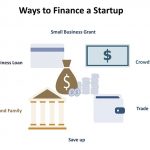It may sound a little callous, but money makes the world go around. No matter how great your idea for a business happens to be, the wheels aren’t going to be set in motion if you don’t have any money to fund it!
From its inception to the end, a business will need quick capital injections every now and then. This is used to start the business in the first place, encourage growth, and sometimes just to get it through a rough patch without any serious damage. Securing funds for a business certainly isn’t a simple or trivial subject, and it’s important to understand it in as much detail as possible. Here’s a guide to funding your small business.

The first thing you need to know is that there’s two main ways to bring in funds for a business: equity and debt. If you go with the debt option, the investor will receive a note for his or her capital, which will outline the terms of repayment, including when it needs to be paid and any interest tied to it.
The main benefit here is that you get to retain your ownership of the business, and full control over what it does. Of course though, there’s one big, overarching downside: you’ll be in debt and will have to pay up! If you fail to do this under certain circumstances, the lender who gave you the capital in the first place can force your business into liquidation.
If you choose the equity option, things are slightly different. Here, you hand over a certain stake in your business to an investor, in return for their capital. In some ways the opposite to debt, the upside here is that you don’t have to worry about paying anything back. The downside is that you have to give up part of the ownership and control.
These are the main factors differentiating debt and equity. You’ve probably decided which of the two options you’re happier with already. However, within these categories, there are many different sources and methods for securing your funds. Here are some of the examples which may be open to you.
Equity

Bootstrapping
One of the simplest, but least common methods of equity funding is called “bootstrapping”. In this model, the business simply funds itself. As it progresses and grows, it carves cash out of its profit margins, and uses this to enable more growth. This can be hard to bring yourself to do, as bootstrapping means there’ll be less capital making it into your personal account. For this reason, bootstrapping usually isn’t the first choice of a lot of business owners.
I recall coming across one entrepreneur who approached another and pitched for an angel investment. After looking at some of their business’s records, the second entrepreneur turned them down. However, they also had a closer look at their pipeline, which showed the first business owner that his current sales were more than enough for the growth he wanted. If your freedom and flexibility comes before all else, then bootstrapping may be the way to go.
Angel Investors
Seen as we’ve touched on “angel investors”, this is the funding route we’ll look at next. If you’ve ever seen “Shark Tank” or “Dragon’s Den”, you’ll have some idea of how angel investors work. These investors are typically very affluent, and willing to invest in promising businesses. More and more, we’re seeing angel investors who are forming investment groups in order to spread out their financial risk, and pool in their knowledge and experience.
You’ll be able to find various local “angels” online, or may be able to get into contact with them through your chamber of commerce. There’s a fair chance they know all about who’s interested in funding new ideas and ventures.
Crowdfunding
One funding method which has only really sprung up in recent years is known as “crowdfunding”. There are many different companies out there which have set up online platforms where entrepreneurs can pitch their ideas over the internet. When an idea’s fairly successful, there are usually several different investors contributing smaller funds to one business idea. Hence the “crowd” in the name. Because this platform is so young and loosely regulated, crowdfunding can be a little risky for smaller investors. However, if your idea gathers enough attention, it can still be a fantastic way to secure funding!
Partnerships
Partnerships are another fairly common way to gain funds through equity. When you take on a partner for the sake of funding, they may or may not end up as a technical employee of the business. If you can pin down a strategic partner, they can provide a massive benefit to your business by aligning your resources.
Let’s take a property management company for example. This business may choose to make an investment in a rental maintenance company, which they could eventually push work towards.
Debt

Small Business Loan
If you’ve decided you’re going to take the “debt” funding route, then the first option you’re probably going to be considering is getting a small business loan.
In recent years, the number of organizations interested in lending to small businesses has really shot up, and obtaining small business loans is now easier than ever! Almost every lender you come across will want this loan to be secured against some kind of asset, and the interest rates can be very high. While it’s not a given that you’re going to get a raw deal, it’s very important to understand how the interest rates on small business loans work.
I remember speaking to one entrepreneur about one short-term loan he was looking at. The rate was a tempting 3 percent, but the term was 30 days. This may look good on the surface, but with a simple bit of maths, you’ll find that the annual interest rate is actually 36 percent.
Revenue-based Loan
If your business has been up and running for some time, and you’ve got some collateral to throw around, then you may be more interested in going for a revenue-based loan instead. With these, you can borrow a percentage of your annualised revenue, up to 35% depending on the lender.

When you go in for a revenue-based loan, your revenue isn’t just used to calculate how much you’re allowed to borrow, but also how much you need to pay back every month. Your monthly contribution to the interest and principal will change based on your business’s actual revenue. If your business has a cyclical cash flow, possibly due to having a seasonal nature or because you’re in your early days, then a revenue based loan can be a massive help.
Accounts Receivable Factoring
Another niche within debt funding is accounts receivable factoring. This is a good choice if you have customers who pay a given amount of time after the purchase. Like many businesses, you may have some customers who pay you on purchase, and others that pay 30, 60 or even 90 days after. When you use accounts receivable factoring or “A/R”, you can borrow money based on the capital that’s owed to you for purchases.
Before pursuing this kind of funding though, you need to be aware that the funding’s based on the quality of your active contracts. If you’re a highly successful B2B enterprise, and have a customer base full of big names, then you’ll get this kind of loan with no issue at all. However, if all your contracts are with small, unknown start-ups, then your chances are going to be very slim.
Monthly Recurring Revenue Line of Credit
A monthly recurring revenue line of credit may also be a good choice for your business. Not all that different from a revenue based loan, in this model you’re allowed to borrow up to five times your monthly recurring revenue. If your business has been running healthily for some time, then this is certainly a viable way to pump in more capital and instigate further growth. This is generally associated with SaaS companies. Considering it’s 2016, there’s a pretty good chance that this is the kind of business you’re operating!
Revolving Line of Credit
If you’re having issues with the seasonality of your product, delayed invoice payments, or something similar, then having a revolving line of credit can smooth out your fluctuations. In most cases though, you need to be aware that it won’t fund a lot more than that.
If a company were to earn £1m a month from customers who usually pay in 60 days, the company will have around £2m in receivables, and £1.5m as their line of credit. However, if the company deals in subscription-based software, and has thousands of clients paying monthly through credit cards, it becomes something of a double-edged sword. The company won’t need to fund their receivables balance, as they’d be getting cash up front. On the other hand, there won’t be any receivables so a bank won’t cough up a line of credit.
If you’re feeling confused about how to secure funds for your business, then I hope this post has helped. Go through all your options in detail, and pretty soon you’ll find the one that’s best for you.











